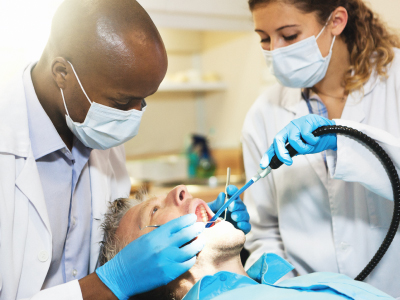Porcelain Crowns
Porcelain Crowns in San Antonio
The Benefits of Porcelain Crowns – Caps
Dental crowns, also called caps, fit over worn or damaged teeth. They can also serve a cosmetic purpose, restoring a discolored tooth to its former hue. Your dentist may fit you with a temporary crown to protect a damaged tooth while the permanent crown is being made. Depending on the material used to make them, the wear they get and the care they receive, permanent crowns last about 5 to 15 years.
Who Needs Dental Crowns?
Crowns serve many purposes in restorative and cosmetic dentistry. They are an integral part of providing support to weakened or broken teeth. Untreated dental problems can lead to jaw pain, headaches and bite anomalies that could do further damage to otherwise healthy teeth.
When Your Dentist Will Recommend Crowns:
- Protecting soft or weakened teeth
- Supporting extensively filled teeth
- Anchoring bridgework
- Restoring the appearance of misshapen, chipped or discolored teeth
- Covering a dental implant
- Rebuilding a tooth after a root canal
- Creating a healthy bite
Types of Crowns
Dental crowns fall into three categories: full metal, porcelain fused to metal and porcelain. Your dentist will assess your dental health and discuss your options with you, but all three crown types have distinct advantages.
All-Metal Crowns
Precious metals have tremendous durability and are non-reactive. These characteristics make them a preferred material for dental crowns. Gold alloys are the most common metal for crowns, but some dentists also work in platinum or palladium alloys that have a silvery hue. Metal crowns offer outstanding longevity, but because they look nothing like natural tooth enamel, they are most often used for molars where they will not be as visible.
All-Porcelain Crowns
Porcelain crowns have the most natural look and are generally indistinguishable from natural teeth. Due to advancement in ceramics they are every bit as strong as metal or PFM crowns. New CAD/CAM techniques allow dentists to create crowns in minutes, but the procedure is typically costly. Porcelain crowns made in this way wear at the same rate as natural teeth.
How Crowns Are Applied
Your dentist will give you a local anesthetic to numb the area before preparing teeth to receive crowns. Biting on carbon paper shows how your teeth meet, ensuring the crown will not interfere with your bite. After the bite impression, you will be fitted with a dental dam to protect the rest of your mouth from tooth dust and keep the restoration site dry. With a high-speed drill, the dentist will then reshape any teeth needing crowns. Reshaping may involve minor filing, or it could necessitate removal of more material to leave a peg-like anchor point for the crown. The amount of your natural tooth that must be removed depends on the type of crown you’re getting and the reason for the restoration.
After shaping the tooth to prepare it for the crown, your dentist will take another bite impression. This step is essential to making the cap fit the remaining tooth perfectly. If you are getting same-day porcelain crowns, you have only a 20-minute wait. Metal and PFM crowns take more time to prepare; you will get a temporary acrylic crown and return in a few weeks to get the permanent crown fitted. In either case, the dentist will apply cement to the crown and press it into place.
If you get temporary crowns, ask your dentist about specific care requirements until the permanent crowns are ready. Some common precautions to take with temporary crowns include:
- Chewing on the other side of your mouth
- Avoiding caramel, toffee and other sticky foods that could loosen the dental work
- Sliding floss from between the crowned teeth instead of lifting it free
- Caring for Dental Crowns
Your new crowns look, feel and behave like your natural teeth, and they need the same care. Follow the brushing and flossing schedule your dentist recommends. Metal-based crowns may feel more sensitive to heat and cold initially but should adjust quickly. Contact your dentist if you notice the following concerns after receiving crowns.
- Difficulty or pain when chewing
- Pain in your head or jaw
- Loosening or wiggling of the crown
- Rough or jagged spots that could indicate a chipped porcelain crown


 We will be disinfecting all counters, door handle and hard surfaces in the waiting room at regular intervals. Also, we will ask all patients to use disinfection wipes that the front desk team members will provide before signing in and checking out. We as a rule disinfect hard surfaces and equipment in our operatories based on infection control guide lines.
We will be disinfecting all counters, door handle and hard surfaces in the waiting room at regular intervals. Also, we will ask all patients to use disinfection wipes that the front desk team members will provide before signing in and checking out. We as a rule disinfect hard surfaces and equipment in our operatories based on infection control guide lines. Please keep your regular dental appointment if you are not ill or have not come into contact with ill patients.
Please keep your regular dental appointment if you are not ill or have not come into contact with ill patients.